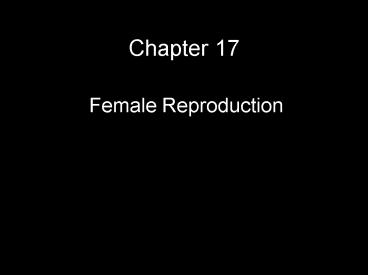Female Reproduction - PowerPoint PPT Presentation
1 / 27
Title:
Female Reproduction
Description:
Oviduct (a.k.a., Fallopian Tube) After ovulation eggs enter oviduct ... Ovarian Cycle: oocytes mature and are released. Follicle develops under the influence of FSH ... – PowerPoint PPT presentation
Number of Views:98
Avg rating:3.0/5.0
Title: Female Reproduction
1
Chapter 17
- Female Reproduction
2
The Female Reproductive System Produces Eggs and
Nurtures the Embryo and Fetus
3
(No Transcript)
4
(No Transcript)
5
(No Transcript)
6
Female Reproductive System
- Ovaries release oocytes and secrete the hormones
estrogen and progesterone - Oviduct (a.k.a., Fallopian Tube)
- After ovulation eggs enter oviduct
- Site where fertilization occurs
- Site of ectopic pregnancy
7
(No Transcript)
8
(No Transcript)
9
Female Reproductive System
- Uterus the organ where fertilized egg grows and
develops - Layers
- Endometrium supports fertilized egg, sloughs off
during menstrual flow - Endometriosis ectopic growth outside uterus
- Myometrium Thick muscular layer, expands during
pregnancy responsible for labor contractions
during childbirth - Cervix the narrow opening in the lower part of
the uterus that permits sperm to enter the uterus
10
The Ovarian Cycle
- Involves egg production and ovulation
11
(No Transcript)
12
Mature (Graafian) Follicle
13
The Menstrual Cycle
- The ovarian and uterine cycles are coordinated by
hormones - Estrogen, Progesterone
- Luteinizing Hormone (LH)
- Follicle Stimulating Hormone (FSH)
14
Menstrual Cycle Ovarian Cycle
- Ovarian Cycle oocytes mature and are released
- Follicle develops under the influence of FSH
- Follicle produces increasing estrogen
- Follicle matures (Graafian follicle) produces
lots of estrogen - Increasing estrogen causes surge of LH (positive
fdbk) which induces ovulation - Corpus luteum (CL) formed from follicle, large
amounts of progesterone secreted - CL degenerates and progesterone declines
15
Menstrual Cycle Uterine Cycle
- Uterine cycle prepares uterus for pregnancy
- Menstrual phase (days 1-5) Progesterone levels
decline ? endometrial lining degenerates ?
menstruation occurs - Proliferative (follicular) phase (days 6-14)
Estrogen increases ? causes endometrial lining to
proliferate - Ovulation (day 14) Induced by high estrogen LH
- Luteal phase Corpus luteum produces progesterone
(and estrogen) ? endometrium proliferates further
to prepare for implantation
16
(No Transcript)
17
Hormonal Control of Endometrium Menstrual
Bleeding
18
(No Transcript)
19
(No Transcript)
20
Maintenance of Menstrual Cycle
- Positive and negative feedback of steroid
hormones on the pituitary - Positive feedback
- At the end of follicular growth phase, increasing
(i.e., very high) estrogen levels cause surge in
LH - Negative feedback
- In both follicular and luteal phases, steady (but
lower) levels of estrogen and progesterone
inhibit LH and FSH release
21
Figure 16.8
22
Mammalian Egg with Sperm
Human Egg with Sperm
Zona Pellucida
23
(No Transcript)
24
Menopause ends a womans reproductive ability
- Two hypotheses
- Ovaries become depleted of eggs
- Aging hypothalamus secretes less GnRH ? less LH
and FSH secretion from pituitary
25
(No Transcript)
26
Infertility Inability to Conceive
- Many causes of infertility
- Number and quality of sperm, pelvic inflammatory
disease (PID), endometriosis - Enhancing fertility
- Options artificial insemination, in vitro
fertilization, GIFT and ZIFT, fertility enhancing
drugs, surrogate mothers
27
(No Transcript)































